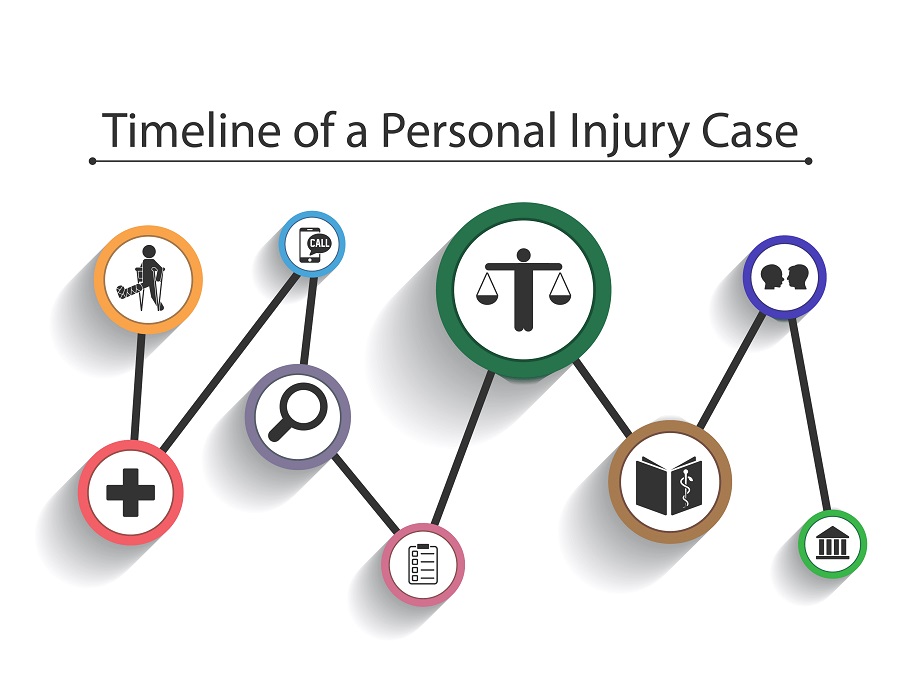
Navigating the journey to justice after an accident can be overwhelming, particularly for people unaccustomed to the legal system. The personal injury case process often unfolds gradually, involving various stages that can be complex and confusing. Many people may envision a dramatic courtroom showdown, but the reality is that most cases are resolved through negotiation and settlement.
Understanding the timeline of a personal injury case is crucial for victims seeking fair compensation for their injuries. This article will outline the essential stages of the process, providing clarity and guidance for those taking steps toward recovery.
Getting Help From a Lawyer
A dependable attorney will guide you through the complex legal process, ensuring that all necessary evidence and documentation are appropriately gathered. During your initial consultation, the legal professional will assess your claim’s specifics and explain how they can assist you.
If legal representation is warranted, you will sign a contract that formalizes the attorney-client relationship, detailing their obligations and fees. With their expertise, you will be better positioned to secure the compensation you deserve.
Starting the Investigations
Once you have secured legal representation, the investigation process for your personal injury case begins in earnest. Your lawyer will request all relevant documentation from you, such as photos of the accident scene, images of the property damage, and any medical records or receipts for treatment. This evidence is vital for understanding the circumstances of your injury and the extent of the damages.
Simultaneously, your lawyer will contact the insurance company of the party at fault and, if applicable, their legal representation. While this investigative work unfolds, let your legal team concentrate on building a strong case while you work toward healing and regaining your normalcy.
Sending the Settlement Demand
This letter is sent after sufficient evidence has been gathered to support your claim. It is directed toward the at-fault party, their insurer, or their legal counsel, outlining the specifics of the accident, the injuries sustained, and the overall impact on your life. In addition to detailing your damages, the letter formally requests compensation, signaling the intention to seek a resolution before escalating to litigation.
After the demand letter is dispatched, your legal representative will engage in negotiations with the insurer. They will carefully assess any settlement offers received, providing professional insights to help you make an educated decision. Ultimately, while your attorney’s guidance is valuable, accepting a settlement rests with you.
Submitting a Personal Injury Case
Your attorney may file a lawsuit if you cannot reach a fair settlement after negotiations with the at-fault party. This course involves preparing and submitting a complaint or petition to the court, which outlines your allegations, the nature of your injuries, and the damages incurred.
Once filed, this document will be served to the defendant, prompting them to hire a legal representative and respond within a stipulated timeframe, usually 30 days. As the suit progresses, the court will set deadlines for various stages, although these can be adjusted as required. The lawsuit process can take months to years, depending on the complexity of the claim and the amount of evidence needed.
Gathering More Evidence Before the Trial
This discovery phase involves taking depositions, where witnesses and involved parties are questioned under oath, creating a record that can be used in court. Additionally, your party may submit interrogatories—written questions that require detailed responses—and request relevant documents to strengthen your argument.
Alongside these measures, your lawyer can conduct interviews with third-party witnesses who may provide valuable insights into the incident. These efforts are crucial in building a comprehensive case, ensuring both sides have the information to pursue a fair resolution before the trial begins. If disputes arise, formal motions can be filed to address specific issues.
Going to Trial
In this stage, your lawyer will prepare you for the courtroom experience, explaining what to expect, courtroom etiquette, and the trial process. The trial typically unfolds through several key stages, including:
- Jury Selection
- Opening Statements
- Witness Testimony
- Cross-Examination
Each side will present their arguments—your attorney will lay out the facts and evidence supporting your claim, while the defense will argue against liability. After both parties have made their cases, the judge or jury will decide whether the defendant is accountable for your injuries and the compensation you may be entitled to.
Navigating Post-Trial Outcomes
After a verdict is reached in a personal injury lawsuit, the journey is not necessarily over. If you win the ruling, the lawyer will first address any liens against the monetary award, ensuring medical providers and other claimants are compensated before deducting fees and expenses. Once these payments are settled, you will receive your final award, marking the formal resolution of the lawsuit.
However, it’s essential to remain aware that both parties retain the right to appeal, alleging procedural errors or judicial misinterpretations during the trial. Each state has unique rules governing the appeal process, which can significantly impact the timeline.
Take the First Step Towards Justice Today!
You don’t have to face the personal injury case process alone. Seeking guidance from a skilled lawyer can make a significant difference in obtaining the compensation you deserve. Get in touch with a trusted personal injury attorney today for a consultation, and let them guide you through each stage of your case.









